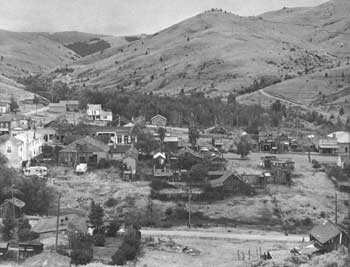






Survey of Historic Sites and Buildings
 |
VIRGINIA CITY Montana |
 |
| ||
Ownership and Administration. Various.
Significance. The strike at Alder Gulch was a memorable episode in frontier mining history. Virginia City, the camp established after the strike, became the center of the Montana gold rush and served as the Territorial capital from 1865 to 1875. At its peak it had a population of 10,000, and mines in the vicinity yielded about $70 million in gold. Virginia City is also closely associated with one of the most famous vigilante actions of the mining era—the hanging of Henry Plummer and his gang of road agents near Bannack. Little is done in the vicinity today.
 |
| Virginia City, Montana, sprang into existence after prospectors discovered gold at Alder Gulch. It was the Territorial capital from 1865 to 1875. A large number of buildings from the gold-rush period survive in the modern town, pictured here. |
Present Appearance. Lower Wallace Street, the historic section of Virginia City, has been restored in an outstanding manner by millionaire rancher Charles A. Bovey. It has numerous false-fronted stores, wooden sidewalks, and old-fashioned street lamps. The stores are even stocked with antique merchandise. Some of the structures, such as the Wells-Fargo express office and the dress maker's shop, contain life-sized figures dressed in the historic fashion. The barber shop, built in the 1870's, appears ready for business.
Among the older buildings, constructed of brick and native stone, are the Territorial capitol and the building that housed the office of the Montana Post. At the Bale of Hay Saloon are nickelodeons and large clanging music boxes. Beyond it stands the old stone barn, now used as a theater; during the summer months, the Virginia City Players enact old-time melodramas. Nearby is the famous Boot Hill Cemetery, where several of Henry Plummer's agents are buried. [21]
NHL Designation: 07/04/61
 |
 |
http://www.cr.nps.gov/history/online_books/prospector-cowhand-sodbuster/sitec11.htm
Last Updated: 22-May-2005